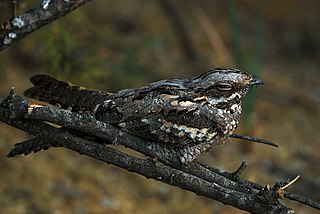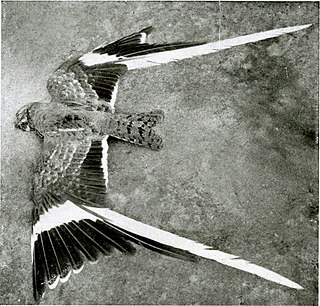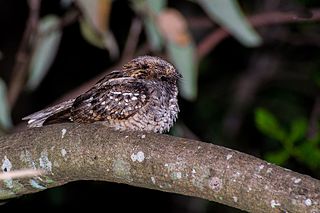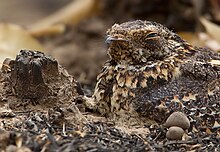
The European nightjar, common goatsucker, Eurasian nightjar or just nightjar, is a crepuscular and nocturnal bird in the nightjar family that breeds across most of Europe and the Palearctic to Mongolia and Northwestern China. The Latin generic name refers to the old myth that the nocturnal nightjar suckled from goats, causing them to cease to give milk. The six subspecies differ clinally, the birds becoming smaller and paler towards the east of the range. All populations are migratory, wintering in sub-Saharan Africa. Their densely patterned grey and brown plumage makes individuals difficult to see in the daytime when they rest on the ground or perch motionless along a branch, although the male shows white patches in the wings and tail as he flies at night.

The red-necked nightjar is the largest of the nightjars occurring in Europe. It breeds in Iberia and North Africa, and winters in tropical West Africa.

The Egyptian nightjar is a medium-small nightjar which occurs in south west Asia and north Africa and winters in tropical Africa. This is a fairly common species with a wide distribution which faces no obvious threats apart from habitat destruction, so the International Union for Conservation of Nature has rated its conservation status as being of "least concern".

The Indian nightjar is a small nightjar which is a resident breeder in open lands across South Asia and Southeast Asia. Like most nightjars it is crepuscular and is best detected from its characteristic calls at dawn and dusk that have been likened to a stone skipping on a frozen lake - a series of clicks that become shorter and more rapid. They are sometimes spotted on roads when their eyes gleam red in the spotlight of a vehicle. There is considerable plumage variation across its range and can be hard to differentiate from other nightjars in the region especially in the field.

Jerdon's nightjar is a medium-sized nightjar species native to southern India and Sri Lanka. Formerly considered as a subspecies of the long-tailed nightjar, it is best recognized by its distinctive call which sounds like a wooden plank being beaten periodically with each note ending in a quaver. The common name commemorates Thomas C. Jerdon who described the species.

The pauraque – also called the common pauraque to distinguish it from similar species – is a nightjar species, one of two birds in the genus Nyctidromus. It breeds in the subtropical and tropical regions of the New World, and except for northernmost birds it is largely resident all year round.
Prigogine's nightjar or the Itombwe nightjar, is a bird species of tropical central Africa. It is known from only one specimen taken at Malenge in the Itombwe Mountains in Zaire in August 1955.

The common poorwill is a nocturnal bird of the family Caprimulgidae, the nightjars. It is found from British Columbia and southeastern Alberta, through the western United States to northern Mexico. The bird's habitat is dry, open areas with grasses or shrubs, and even stony desert slopes with very little vegetation.

The pennant-winged nightjar is a species of nightjar that occurs from Nigeria to northern South Africa. It is an intra-African migrant and displays remarkable sexual dimorphism in the breeding season.

Bates's nightjar or the forest nightjar, is a bird species of the family Caprimulgidae, found in the rainforests of western Sub-Saharan Africa.

The band-winged nightjar or greater band-winged nightjar is a species of nightjar in the family Caprimulgidae. It is widespread in South America, where it is found in the Andes, Venezuelan Coastal Range, Santa Marta Mountains, Tepuis, most of Chile, Argentina, Paraguay, Uruguay, and eastern Brazil. It occurs in a wide range of habitats, from the edge of humid montane forests to shrubby semi-deserts and urban rooftops.

The blackish nightjar is a species of bird in the family Caprimulgidae. It is found in Brazil, Bolivia, Colombia, Ecuador, French Guiana, Guyana, Peru, Suriname, and Venezuela.

The little nightjar is a species of nightjar in the family Caprimulgidae. It is found in Argentina, Bolivia, Brazil, Paraguay, Peru, and Uruguay.

The fiery-necked nightjar is a species of nightjar in the family Caprimulgidae, which is found mostly in Africa south of the equator, though it has been spotted in a few countries north of the equator. It is most often found in woodland savannas or other deciduous woodlands. It is usually distinguished by its tawny coloured collar which gives the species its common name. It has a distinctive call that many have rendered as 'good-lord-deliver-us'. The fiery-necked nightjar is an insectivorous species that mostly eats butterflies, moths and other insects. The fiery-necked nightjar breeds after the dry season and typically produce two clutches with two eggs per clutch.

The rufous-cheeked nightjar is a species of nightjar in the family Caprimulgidae. It is an intra-African migrant that breeds in the south of its range. It spends the non-breeding season in eastern Nigeria, Cameroon, southern Chad and Sudan, the Republic of the Congo, the D.R.C. and western Central African Republic. Throughout the year it can be found in Southern Africa. It is a nocturnal species that feeds on flying insects, mainly hunting at dusk and the early night. They can hunt at night thanks to their large eyes that are adept at seeing in the dark. They cannot see in complete darkness and most likely cannot see colours either. The rufous-cheeked nightjar forms monogamous pairs and the egg laying period is from September to November. It looks very similar to other African nightjars and they are frequently misidentified during research and studies.

The dusky nightjar or dusky whip-poor-will is a species of nightjar in the family Caprimulgidae. It is found in Costa Rica and Panama.

The freckled nightjar or freckled rock nightjar is a species of nightjar in the family Caprimulgidae. It has a wide yet patchy distribution throughout the Afrotropics.

The spotted nightjar or spotted eared-nightjar is a species of nightjar in the family Caprimulgidae. It inhabits much of mainland Australia and has also been found in several Indonesian islands. Its natural habitats are open forests and woodlands, scrub, spinifex and tussock grassland, savannah woodland and mangroves.

The scissor-tailed nightjar is a species of nightjar in the family Caprimulgidae. It is distributed over much of eastern South America.

The swallow-tailed nightjar is a species of nightjar in the family Caprimulgidae. It is found in Bolivia, Colombia, Ecuador, and Peru.





















